Dean &
Ginny's excellent adventures... Main
Adventure Page
Grand
Voyage--2012:
<<
Part 1 <<
Part 2 <<
Part 3 <<
Part 4 <<
Part 5 <<
Part 6 <<
Part 7 <<
Part 8
<<
Part 9 Part
10 Part
11 >>
Part 12 >>
Part 13 >>
Part 14 >>
Part 15 >>
Part 16 >>
Part 17 >>
Part 18 >>
Part 19 >>
Part 20 >>
Part 21 >>
Part 22 >>
Part 23 >>
Part 24 >>
Part 25 >>
|
|

Sunrise over Rapa Nui (Easter Island) revealed that we had anchored on
the north side of the island at Anakena Beach rather than the south side
next to the town--Hanga Roa. There were only four-foot swells here
rather than the six-foot ones on the south side of the island.
 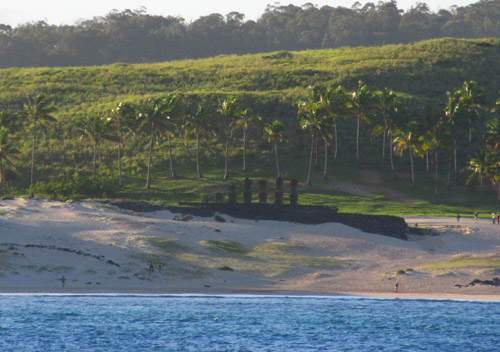
It took a while for the crew to prepare the landing site, so we were about
an hour later than scheduled to go ashore. Since we'd not signed
up for an expensive shore excursion organized by the ship, we had to
wait until the first shore excursion people were all ashore before we
could board a tender. While we waited, we could see that there were five
moai lined up on an ahu at the top of the beach area--more on the moai
later. This is our first stop in Polynesia (meaning many islands), which
includes a large triangular area in the south Pacific and north to Hawaii.

Once our tender was loaded, the captain of the ship,
Jonathan Mercer, stepped on board looking like any other tourist with his dark glasses,
fancy camera, and tote bag.
When we came ashore we headed away from the beach (and
the crowd) up on a hill to the left.
|
|

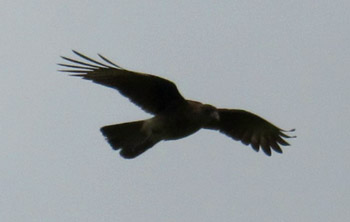
We saw several of these hawks working the hillside. We
later determined that they are Chimango Caracaras, a falconoid scavenger, not
a true hawk.
Below a male and female sit at the edge of the hill.


I don't know what the native vegetation might look like, since I could
see a combination of tropical milkweed (the orange flower), guava,
thistle, plantain weed and other plants that have also escaped cultivation in Florida. The island has been stripped of its trees and
has been used for livestock since Europeans moved in. The island's
history is a sad tale of tribal wars, the enslaving of the native
population to dig up bird guano from another island, the loss of the
native language, and much more. But what remains is so
intriguing.
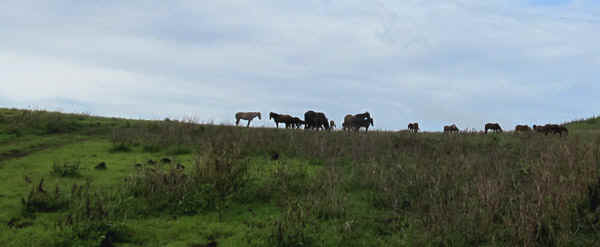
On our walk we found a herd of horses up on the hill that sort of edged away as we approached.
There were a couple of horse or cattle skeletons in the area that the
caracaras picked at, but we thought this one horse might have been
startled when one of them landed on its rump and tried to whisk it away
with its tail. The branding seemed primitive.

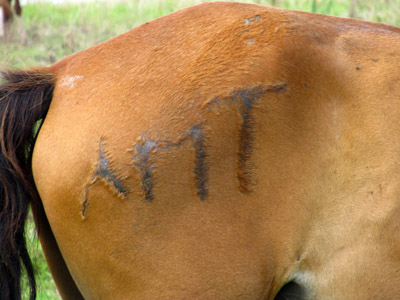
 |
 |
|

We enjoyed the solitude, the stonework and the
views, but we had expected to see moai all along the shore. When we
found only some of the foundations or ahus, we worked our way back
to the beach area.
|
 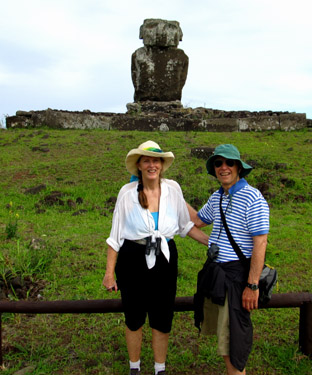

We took photos of the moai at the beach. Each one is different--it's
thought that they represent ancestors who will take care of their
survivors. Their backs are normally toward the sea. Some have hats
made of a redder type of volcanic rock and some have elongated
ear lobes--a native tradition. This island has three main volcanoes,
which have been silent for more than ten thousand years.

|
|


Coconut palms grace the upper beach--one young man shinnied up one
to harvest a coconut for his girl.
|
|

We crossed to the opposite side of the beach where
local merchants had set up their wares. We found a taxi driver there who would take us to the quarry (cantera),
where the moai were made, for $60 round trip. It may seem expensive,
but with our purchasing the $60 park entrance fee each plus his fee,
it was only $180 for both of us while the same excursion offered by
the ship would
have cost us $400.
Our cab driver Josť not only dodged the free-range
horses in the road, but he also stopped at the Tongarikki where 15
moai are lined up. We got out on one side, and he picked us up on the
other. Our timing was good--between the organized tours.
|
|





This one moai was not facing away from the sea, but was probably
placed more recently to face
the gate
as a welcome to the park.




|
|
|

We could see the cantera (Rano Raraku on the map above) from the road as
we approached. It was on the opposite side of the mountain we saw
from the Tongarikki site.
|
 Josť
dropped us off and promised to meet us in an hour. Josť
dropped us off and promised to meet us in an hour.
The person at the gate of this site asked where we
were from (The Amsterdam), checked our receipts from the $60 fee
we'd paid that morning, and stamped them.
We started on the path up to the hill, but on the
way we saw some broken moai in the fields.>>
Again, our timing was good--between organized tours.
Walking among all these moai was simply amazing.
|
|



These two moai were "in-progress" when
the whole operation stopped. They've never been removed. The
others in the area may have been mounted at one time, but probably
not. It's not easy to trace the moai placements through the tribal
wars and occupations. When explorer Captain John Cook arrived here
in 1744, many of the moai had already been knocked down.
|
|

|

The ones under construction lie in the stone outcropping of the ancient
volcano at the top of the hillside.

|

|
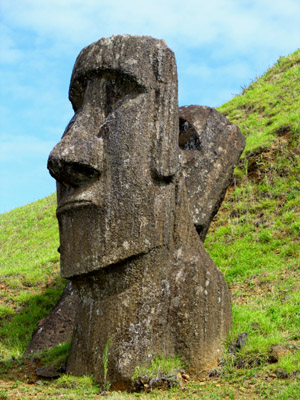
|
|
Some of the lichen on the moai looks like a
disease. Some of the moai have been excavated, while others are
buried up to their noses.
 
|
|
|
After taking a million photos, we hiked around to the calderas
or crater on the other side of the hill. The water that
collects in some of these craters on the island supplies the fresh water
for the 3,000 people who live here--supplies are running low. Bull rushes lined the
crater lake, Rano Raraku Wetland.
 

The moai inside of the crater were off-limits unless you were with
a park ranger.
|
|

We were early in returning to the parking lot and Josť
was nowhere to be seen, so we looked at the souvenirs, the tiki carvings,
and found some more fallen moai. We ate our snack of Fruit Loops--we were
not allowed to bring fresh fruit ashore anywhere in Chile.
 
Josť showed up on time
and took us back to the beach at Anakena. The dirt and stone road made for
a slow, bumpy ride coming and going.
|
|



We saw some of the islands free-range chickens
here. Josť had pointed out the stone chicken houses in the
fields.
We found some
new angles to photograph the moai here and we stuck our feet
in the cool water.

|
|


The Amsterdam had hired a local boat to help out; for most of the
day it stood by with a rope tied to a rock and the little kid snorkeled
around the beach area. But when the
floating platform between the tender and the cement dock failed, the
hired boat dragged the broken platform (with a crew member sitting on it)
back out to the ship. During the reconfiguration, the tender
service was halted and caused a major backup of passengers waiting
to board the ship.


Many of our fellow passengers stood like sheep for hours out in the hot sun
waiting in line.
|
|

We waited in the cool shade up on the hill and
enjoyed the breezes. When tender service resumed and the line was much shorter, we queued up.
The crew gave us iced tea and handed out cool, damp wash cloths.
After we wiped our hands and faces, the cloths were the color of
the red soil.

The crew member on the rocks was
coordinating the tenders. From his vantage point he could
see the tenders coming from the ship and could also see the line
up of passengers.

After we boarded the ship, the lineup of the
passengers from the later tours waiting for tenders looked like a
row of mini-moai. And so we leave this mysterious island with more
questions than answers.
Dean's
Log: Days 32-37
|
|































 Josť
dropped us off and promised to meet us in an hour.
Josť
dropped us off and promised to meet us in an hour.


























